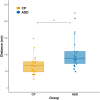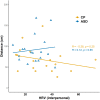Altered interpersonal distance regulation in autism spectrum disorder
- PMID: 37000718
- PMCID: PMC10065277
- DOI: 10.1371/journal.pone.0283761
Altered interpersonal distance regulation in autism spectrum disorder
Abstract
Interpersonal distance regulation is an essential element of social communication. Its impairment in autism spectrum disorder (ASD) is widely acknowledged among practitioners, but only a handful of studies reported empirical research in real-life settings, focusing mainly on children. Interpersonal distance in adults with ASD and related autonomic functions received less attention. Here, we measured interpersonal distance along with heart rate variability (HRV) in adults with ASD, and tested the modulatory effects of eye-contact and attribution. Twenty-two adults diagnosed with ASD and 21 matched neurotypical controls participated in our study from October 2019 to February 2020. Our experimental design combined the modified version of the stop distance paradigm with HRV measurement controlling for eye contact between the experimenter and the participant to measure interpersonal distance. Still, we did not detect significant modulatory effect of eye contact and attribution. Our results showed a greater preferred distance in ASD. Moreover, we found lower baseline HRV and reduced HRV reactivity in ASD; however, these autonomic measurements could not predict preferred interpersonal distance. Our study highlights the importance of interpersonal space regulation in ASD: it might be considered that people with ASD need individually variable, presumably greater interpersonal distance. In addition, regardless of the distance they may have reduced autonomic regulatory capacity in social situations. Our results could help shape future experiments with sophisticated designs to grasp the complexity and underlying factors of distance regulation in typical and atypical populations.
Copyright: © 2023 Farkas et al. This is an open access article distributed under the terms of the Creative Commons Attribution License, which permits unrestricted use, distribution, and reproduction in any medium, provided the original author and source are credited.
Conflict of interest statement
The authors have declared that no competing interests exist.
Figures







References
-
- American Psychiatric Association. Diagnostic and Statistical Manual of Mental Disorders. Fifth Edition. American Psychiatric Association; 2013

